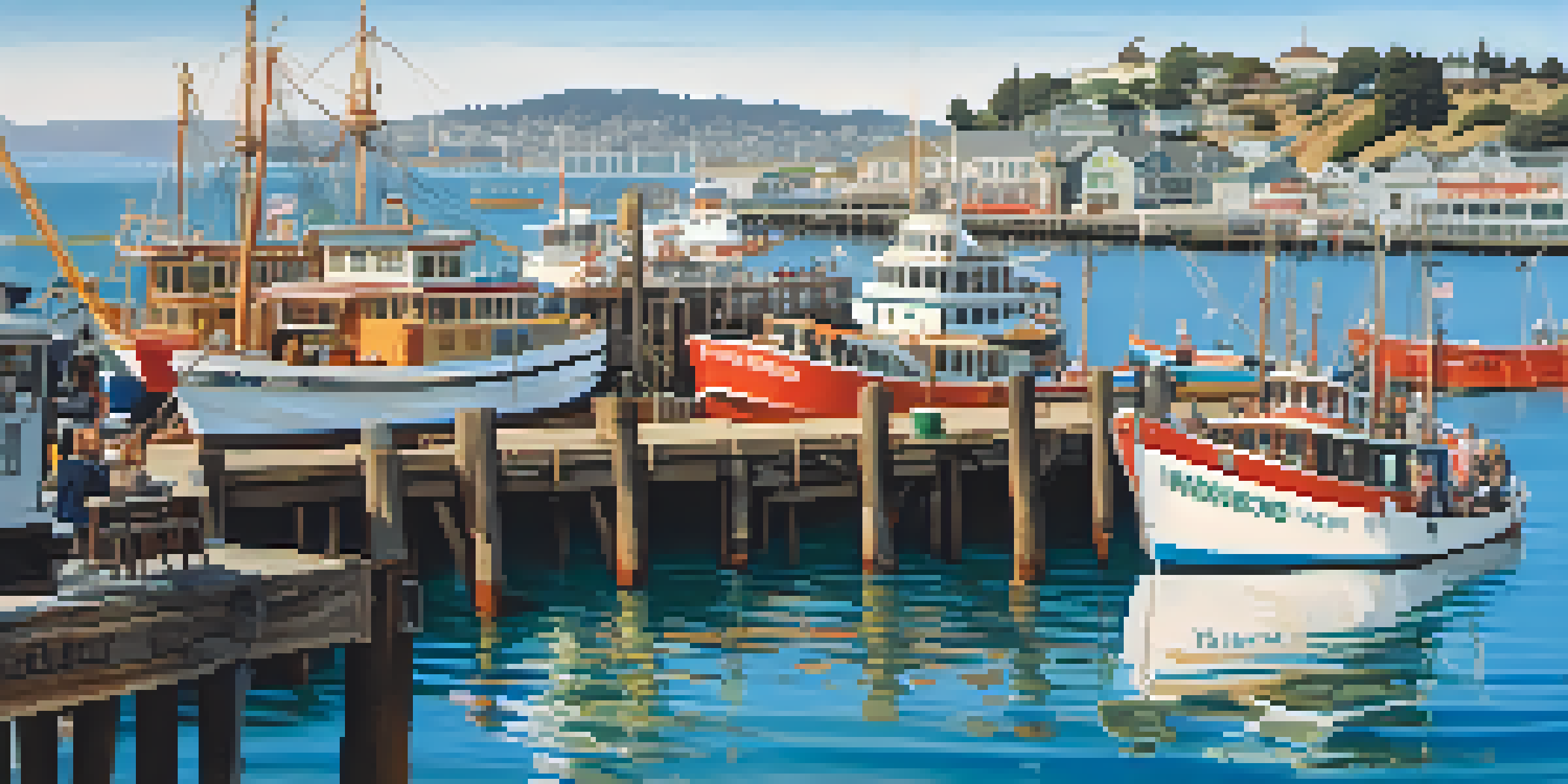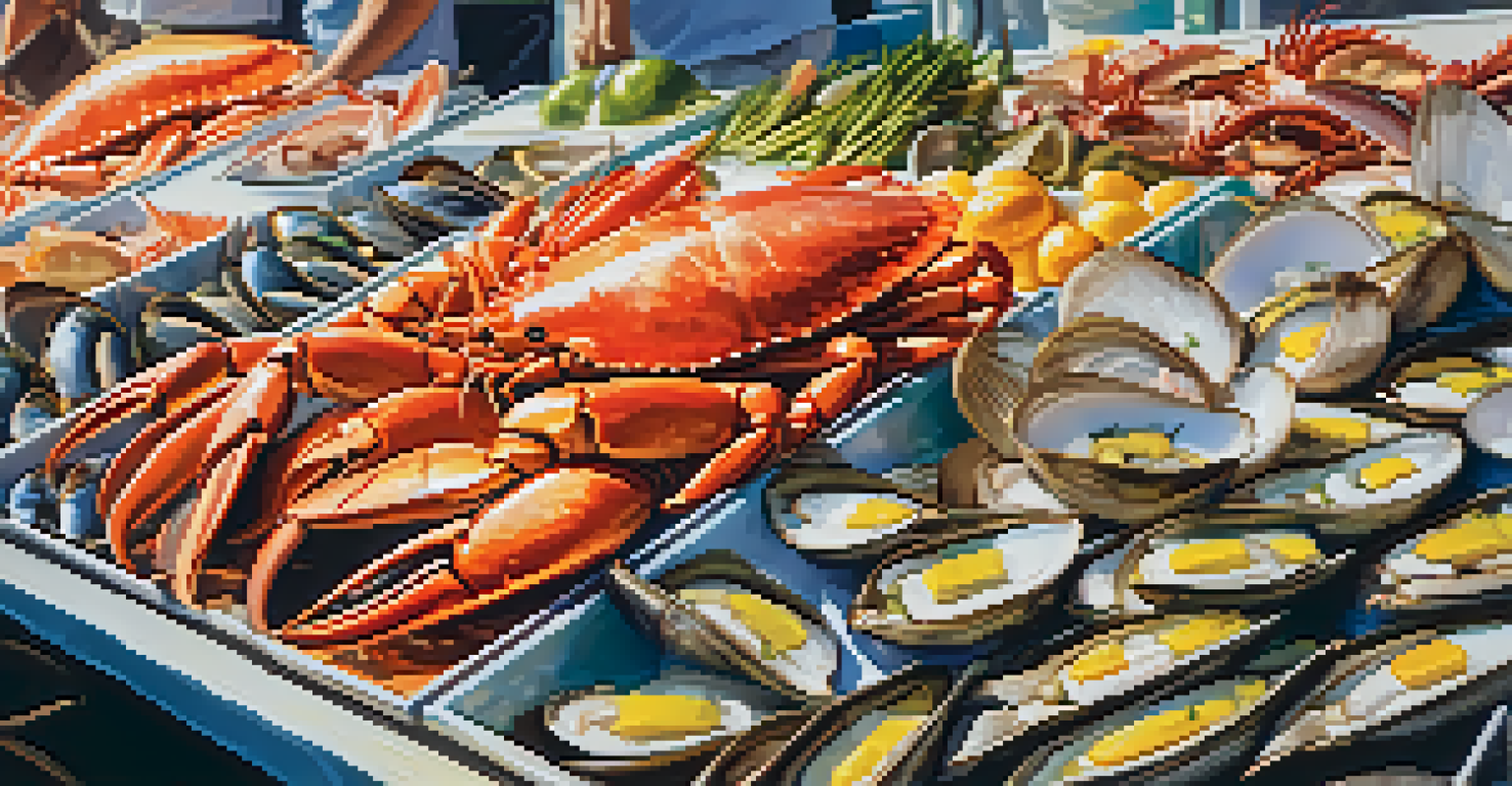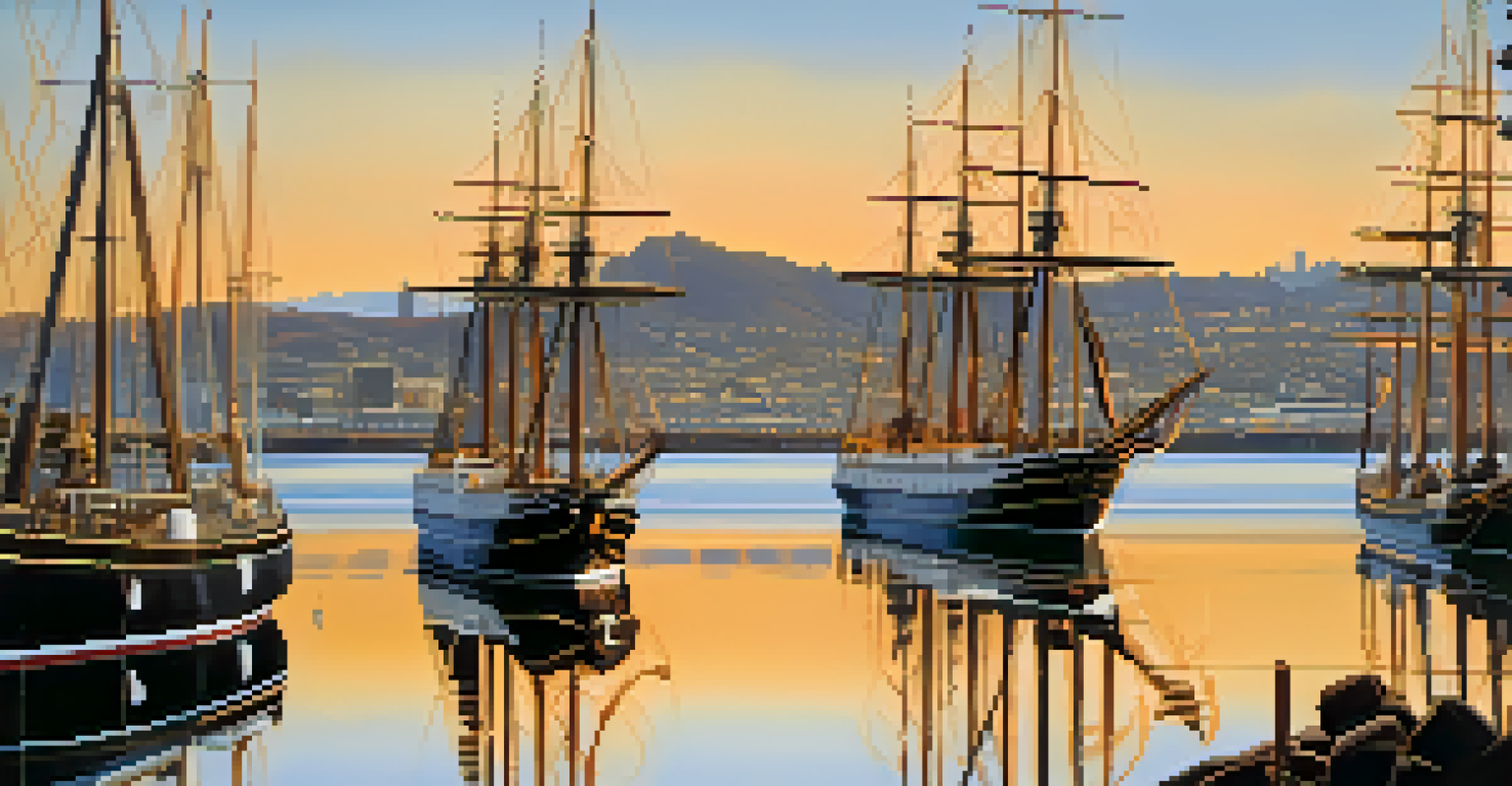The Maritime History of San Francisco's Fisherman's Wharf

The Origins of Fisherman's Wharf: A Historical Overview
Fisherman's Wharf, a vibrant waterfront area in San Francisco, has roots that trace back to the early days of the Gold Rush in the mid-1800s. Initially, it served as a bustling hub for fishermen, particularly those from Italy, who played a pivotal role in shaping the community. The wharf quickly evolved from a simple fishing cove to a critical supply point for ships and seafarers.
The sea, once it casts its spell, holds one in its net of wonder forever.
As the city expanded and the fishing industry flourished, Fisherman's Wharf became synonymous with the maritime lifestyle. The wharf not only provided fresh seafood but also became a central point for maritime trade and commerce. This transformation laid the groundwork for the vibrant fishing culture that still thrives today.
Today, remnants of this rich history can be seen in the architecture and local businesses that celebrate the area’s nautical roots. Many fishing boats still dock here, serving as a reminder of the past while contributing to San Francisco's modern economy.
The Role of Fishing in the Local Economy
Fishing has always been a cornerstone of Fisherman's Wharf, providing livelihoods for generations of local families. From crab to cod, the variety of seafood caught here has not only fed the community but also attracted visitors eager to taste fresh dishes right from the ocean. Restaurants like Alioto's and the Crab Shack have become landmarks, showcasing the bounty of the sea.

The local fishing industry faced challenges over the years, including overfishing and changing regulations. However, the resilience of the fishermen and the support from the community have helped sustain the industry. Today, sustainable practices are emphasized, ensuring that future generations can also enjoy the rich marine resources.
Fisherman's Wharf's Rich History
The area has evolved from a fishing hub in the Gold Rush era to a vibrant cultural and economic destination.
Moreover, the economic impact extends beyond fishing; the wharf has become a tourist magnet, drawing millions of visitors annually. This influx of tourists supports local businesses, creating a vibrant economy that relies on both tradition and innovation.
Iconic Landmarks and Attractions at the Wharf
Fisherman's Wharf is not just about fishing; it's also home to a variety of iconic landmarks and attractions that tell the story of San Francisco's maritime heritage. One such landmark is the historic Pier 39, known for its sea lion population that draws visitors year-round. These playful animals have become a symbol of the wharf and contribute to its lively atmosphere.
Fishing is much more than fish. It is the creative place of man and nature where he can connect with his thoughts.
Another notable attraction is the San Francisco Maritime National Historical Park, which offers a glimpse into the city's rich seafaring past. Visitors can explore historic ships, such as the Balclutha and the Eureka, and learn about the lives of those who sailed them. This park serves as both a museum and a tribute to maritime history.
The blend of history and modern attractions at Fisherman's Wharf makes it an engaging destination for people of all ages. From street performers to artisan shops, there’s always something happening, ensuring that the maritime legacy continues to be celebrated.
Cultural Influences Shaping the Wharf
The cultural tapestry of Fisherman's Wharf is woven from the diverse backgrounds of its residents and visitors alike. Italian immigrants, in particular, played a significant role in shaping the area’s culinary landscape, introducing dishes that have become staples in local cuisine. The blending of cultures has created a unique culinary scene that reflects the wharf's maritime heritage.
Festivals and events, such as the annual Crab Feed and the Italian Heritage Parade, highlight the community's cultural diversity. These celebrations not only honor the traditions of the past but also invite newcomers to participate, fostering a sense of belonging among residents and visitors alike.
Sustainable Fishing Practices Today
Local fishermen are adopting sustainable practices to ensure the long-term health of marine resources.
As a melting pot of cultures, Fisherman's Wharf continues to evolve while retaining its historical essence. This dynamic environment enriches the visitor experience, making each trip to the wharf unique and memorable.
Environmental Challenges and Conservation Efforts
Like many coastal areas, Fisherman's Wharf faces environmental challenges that threaten its delicate ecosystem. Pollution, climate change, and the impact of tourism can disrupt marine life and the fishing industry. Recognizing these threats, local organizations and the community have come together to advocate for sustainable practices and conservation efforts.
One notable initiative is the promotion of sustainable fishing practices among local fishermen. By adhering to regulations and working with environmental groups, fishermen are helping to ensure the long-term viability of fish populations and marine habitats. This collaborative approach highlights the importance of preserving the wharf's natural resources.
Additionally, educational programs aimed at raising awareness about marine conservation are becoming increasingly popular. These initiatives engage the community and visitors, fostering a sense of stewardship for the ocean and its inhabitants, which is crucial for the future of Fisherman's Wharf.
The Influence of Technology on Modern Fishing Practices
As we delve into the modern era, technology has made significant impacts on fishing practices at Fisherman's Wharf. From advanced sonar systems to sustainable fishing gear, these innovations enhance the efficiency and effectiveness of local fishermen. Such advancements allow for better monitoring of fish populations, ensuring that fishing remains a viable profession.
Moreover, technology has also transformed the way seafood is processed and sold. With the rise of online marketplaces, fishermen can now reach consumers directly, bypassing traditional distribution channels. This direct-to-consumer model not only supports local businesses but also fosters transparency regarding the origins of seafood.
Cultural Diversity Enriches the Wharf
The blend of cultures, particularly from Italian immigrants, has created a unique culinary and community experience.
However, while technology brings many benefits, it also raises questions about the balance between tradition and modernization. Fishermen at the wharf are navigating this shift, striving to maintain their cultural heritage while embracing the tools of the future.
Future Prospects for Fisherman's Wharf
Looking ahead, Fisherman's Wharf is poised for exciting developments that honor its rich maritime history while embracing modernity. Ongoing revitalization projects aim to enhance the waterfront experience, making it more accessible and environmentally friendly. These efforts include improved public spaces and infrastructure that celebrate the area’s unique character.
Additionally, the continued focus on sustainable practices in both fishing and tourism is expected to shape the future of the wharf. By prioritizing environmental responsibility, local stakeholders are ensuring that this iconic destination remains vibrant for generations to come.

As Fisherman's Wharf evolves, it will undoubtedly continue to attract visitors eager to explore its history and culture. The wharf stands as a testament to San Francisco's maritime legacy, and its future looks bright, filled with promise and potential.